Hyeonseong Jeon
Tree-Guided Diffusion Planner
Aug 29, 2025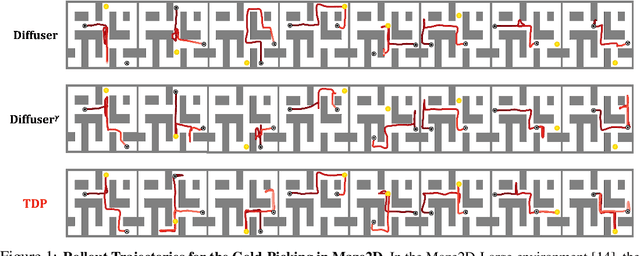

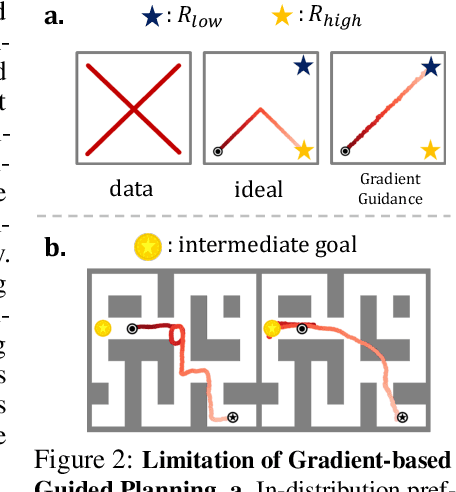

Abstract:Planning with pretrained diffusion models has emerged as a promising approach for solving test-time guided control problems. However, standard gradient guidance typically performs optimally under convex and differentiable reward landscapes, showing substantially reduced effectiveness in real-world scenarios involving non-convex objectives, non-differentiable constraints, and multi-reward structures. Furthermore, recent supervised planning approaches require task-specific training or value estimators, which limits test-time flexibility and zero-shot generalization. We propose a Tree-guided Diffusion Planner (TDP), a zero-shot test-time planning framework that balances exploration and exploitation through structured trajectory generation. We frame test-time planning as a tree search problem using a bi-level sampling process: (1) diverse parent trajectories are produced via training-free particle guidance to encourage broad exploration, and (2) sub-trajectories are refined through fast conditional denoising guided by task objectives. TDP addresses the limitations of gradient guidance by exploring diverse trajectory regions and harnessing gradient information across this expanded solution space using only pretrained models and test-time reward signals. We evaluate TDP on three diverse tasks: maze gold-picking, robot arm block manipulation, and AntMaze multi-goal exploration. TDP consistently outperforms state-of-the-art approaches on all tasks. The project page can be found at: tree-diffusion-planner.github.io.
Convergent Functions, Divergent Forms
May 27, 2025Abstract:We introduce LOKI, a compute-efficient framework for co-designing morphologies and control policies that generalize across unseen tasks. Inspired by biological adaptation -- where animals quickly adjust to morphological changes -- our method overcomes the inefficiencies of traditional evolutionary and quality-diversity algorithms. We propose learning convergent functions: shared control policies trained across clusters of morphologically similar designs in a learned latent space, drastically reducing the training cost per design. Simultaneously, we promote divergent forms by replacing mutation with dynamic local search, enabling broader exploration and preventing premature convergence. The policy reuse allows us to explore 780$\times$ more designs using 78% fewer simulation steps and 40% less compute per design. Local competition paired with a broader search results in a diverse set of high-performing final morphologies. Using the UNIMAL design space and a flat-terrain locomotion task, LOKI discovers a rich variety of designs -- ranging from quadrupeds to crabs, bipedals, and spinners -- far more diverse than those produced by prior work. These morphologies also transfer better to unseen downstream tasks in agility, stability, and manipulation domains (e.g., 2$\times$ higher reward on bump and push box incline tasks). Overall, our approach produces designs that are both diverse and adaptable, with substantially greater sample efficiency than existing co-design methods. (Project website: https://loki-codesign.github.io/)
Learning to Continually Learn with the Bayesian Principle
May 29, 2024Abstract:In the present era of deep learning, continual learning research is mainly focused on mitigating forgetting when training a neural network with stochastic gradient descent on a non-stationary stream of data. On the other hand, in the more classical literature of statistical machine learning, many models have sequential Bayesian update rules that yield the same learning outcome as the batch training, i.e., they are completely immune to catastrophic forgetting. However, they are often overly simple to model complex real-world data. In this work, we adopt the meta-learning paradigm to combine the strong representational power of neural networks and simple statistical models' robustness to forgetting. In our novel meta-continual learning framework, continual learning takes place only in statistical models via ideal sequential Bayesian update rules, while neural networks are meta-learned to bridge the raw data and the statistical models. Since the neural networks remain fixed during continual learning, they are protected from catastrophic forgetting. This approach not only achieves significantly improved performance but also exhibits excellent scalability. Since our approach is domain-agnostic and model-agnostic, it can be applied to a wide range of problems and easily integrated with existing model architectures.
T-GD: Transferable GAN-generated Images Detection Framework
Aug 10, 2020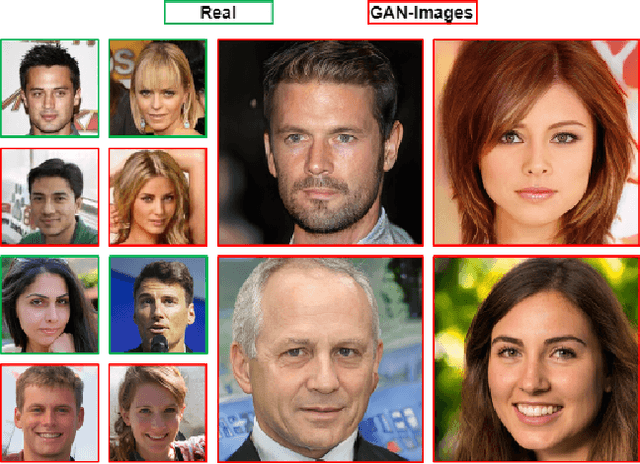
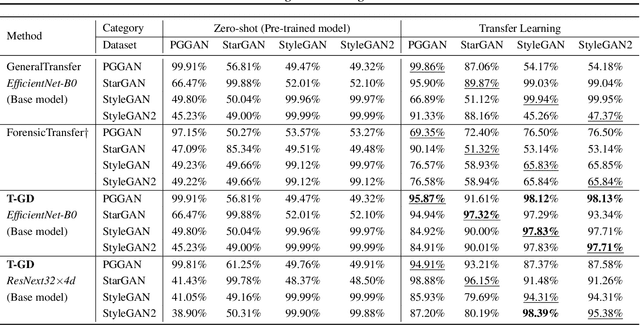
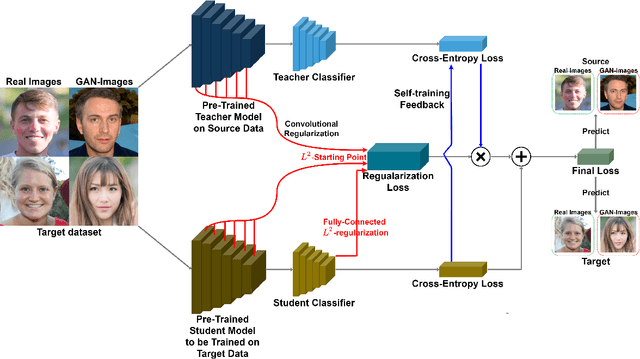

Abstract:Recent advancements in Generative Adversarial Networks (GANs) enable the generation of highly realistic images, raising concerns about their misuse for malicious purposes. Detecting these GAN-generated images (GAN-images) becomes increasingly challenging due to the significant reduction of underlying artifacts and specific patterns. The absence of such traces can hinder detection algorithms from identifying GAN-images and transferring knowledge to identify other types of GAN-images as well. In this work, we present the Transferable GAN-images Detection framework T-GD, a robust transferable framework for an effective detection of GAN-images. T-GD is composed of a teacher and a student model that can iteratively teach and evaluate each other to improve the detection performance. First, we train the teacher model on the source dataset and use it as a starting point for learning the target dataset. To train the student model, we inject noise by mixing up the source and target datasets, while constraining the weight variation to preserve the starting point. Our approach is a self-training method, but distinguishes itself from prior approaches by focusing on improving the transferability of GAN-image detection. T-GD achieves high performance on the source dataset by overcoming catastrophic forgetting and effectively detecting state-of-the-art GAN-images with only a small volume of data without any metadata information.
FDFtNet: Facing Off Fake Images using Fake Detection Fine-tuning Network
Jan 05, 2020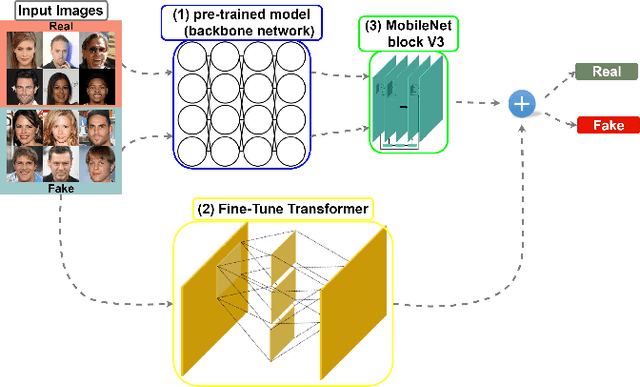
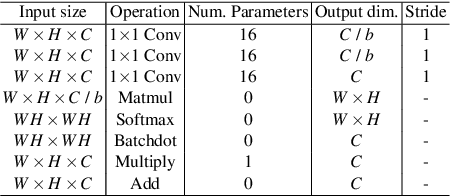
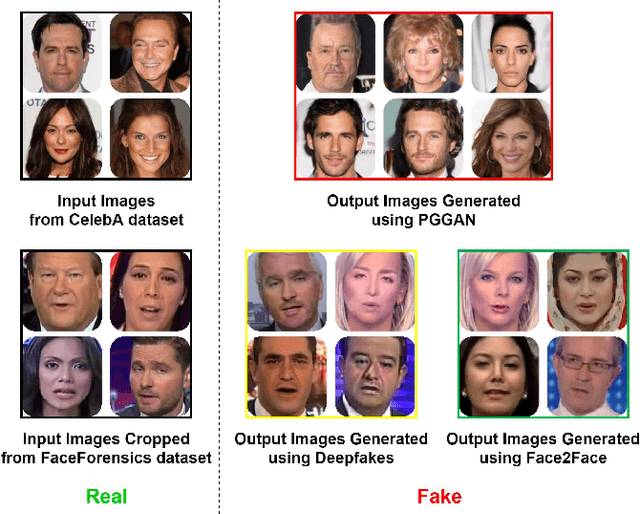
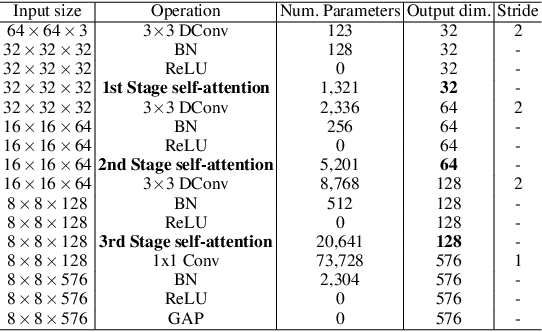
Abstract:Creating fake images and videos such as "Deepfake" has become much easier these days due to the advancement in Generative Adversarial Networks (GANs). Moreover, recent research such as the few-shot learning can create highly realistic personalized fake images with only a few images. Therefore, the threat of Deepfake to be used for a variety of malicious intents such as propagating fake images and videos becomes prevalent. And detecting these machine-generated fake images has been quite challenging than ever. In this work, we propose a light-weight robust fine-tuning neural network-based classifier architecture called Fake Detection Fine-tuning Network (FDFtNet), which is capable of detecting many of the new fake face image generation models, and can be easily combined with existing image classification networks and finetuned on a few datasets. In contrast to many existing methods, our approach aims to reuse popular pre-trained models with only a few images for fine-tuning to effectively detect fake images. The core of our approach is to introduce an image-based self-attention module called Fine-Tune Transformer that uses only the attention module and the down-sampling layer. This module is added to the pre-trained model and fine-tuned on a few data to search for new sets of feature space to detect fake images. We experiment with our FDFtNet on the GANsbased dataset (Progressive Growing GAN) and Deepfake-based dataset (Deepfake and Face2Face) with a small input image resolution of 64x64 that complicates detection. Our FDFtNet achieves an overall accuracy of 90.29% in detecting fake images generated from the GANs-based dataset, outperforming the state-of-the-art.
 Add to Chrome
Add to Chrome Add to Firefox
Add to Firefox Add to Edge
Add to Edge